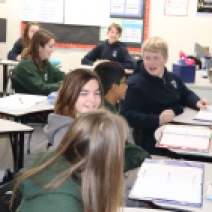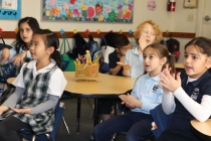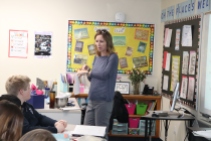Teachers are taught to teach. They are given concepts, tools, and behavioral advice and then placed in a classroom to begin experiencing the actual process of teaching. They cling to those tools knowing there are years of research behind them. Professional development allows teachers to acquire new and updated tools as the years pass. What happens when teachers throw out all their tools and try something completely new for the sake of their students?
The language teachers at High Point Academy did just that. Mrs. Ann Collard has been teaching Spanish at High Point for over 10 years. A couple of years ago, she began to get interested in a new process of teaching Spanish called at that time TPRS (Teaching Proficiency through Reading and Storytelling), now referred to as CI (Comprehensible Input).
TPRS and CI are teaching methods that focus on the way our brains naturally acquire language. This happens when teachers intentionally employ a body of techniques and strategies using specific principles that prioritizes the delivery of understandable, personalized, and relevant messages.
TPRS and CI adhere to Dr. Krashen’s Comprehension Hypothesis that states that language acquisition occurs when we understand messages (Comprehensible Input, or, CI) in the target language (TL). The ability to speak is the result of language acquisition, not the cause. – https://cimidwest.weebly.com/about-tprsci.html
Mrs. Collard attended an introductory class being taught by Anna Parsons-Lamb. She learned two things that evening. One, that she was fascinated enough to want to learn more about this new teaching method, and, two, that she had to get Mrs. Parsons-Lamb on staff at High Point. Mrs. Collard accomplished both goals.
Mrs. Collard studied. She went to multiple trainings locally and attended the national conference in Denver, Colorado, twice. Her teaching style was forever changed after witnessing the “language lab” at the conference. The lab consisted of live classes being taught by master instructors. She and others sat in the back of the classroom and experienced CI being taught in real time which, in her opinion, is much better than just talking theory.
To get a sense of how radically different this teaching style can be, it is necessary to examine the conventional style of teaching a language. Traditional textbooks have pages and pages of vocabulary. The average Spanish 1 textbook has about 3000 words in it. When that many words are taught, there is no guarantee as to what students will remember. In fact, they can end up remembering the most random words like alcachofa (artichoke) or terremoto (earthquake). And then promptly forget the important, high frequency verbs that are used in everyday conversation.
In the CI classroom, lessons are developed around high frequency words or phrases called target structures. Teachers choose a story and activities based on three target structures and their meanings. They use a ‘circling’ methodology which is simply repeat, repeat, and repeat using the same word in different ways in order to get the students to understand the word or phrase. No English is spoken for explanatory purposes. Each class is structured around this three-step process.
- Present one to three target structures with their meanings.
- Ask a story using the target structures.
- Read, discuss, play a video, play games, or sing music using text with the same structures.
A successful teacher will pick out stories and books based on level and interest of their students. Mrs. Collard incorporates lots of activities in each of her lessons to make learning fun and engaging. She remembers her first day teaching using this new method.
After attending a two-day conference on “storytelling” where I spent the majority of the time as a student learning German, it was finally time for me to try this new methodology in one of my own classes. “Storytelling” is supposed to be spontaneous and off the cuff, with the students giving input and driving the details of the story. But for that first story, I had written out my script word for word and even had a whole page of questions to ask in case students needed some encouragement to participate. I gathered a few random props, stealing dress-up clothes from my own kids’ rooms. The night before, I tossed and turned, unable to sleep because of nerves. I was running through the story in my head and the possible outcomes.
After so many years of conducting the majority of the class in English, I wasn’t sure how the students would react to my speaking in all Spanish. Would they be overwhelmed, would they participate, or would they sit and stare in confusion? I really had no way of predicting their reaction.
I walked into second period with a small bag of props, which drew a lot of curious questions. I briefly explained that I was going to experiment for today’s class and was going to speak only in Spanish. They immediately moaned that they wouldn’t understand me, which if we’d done class the traditional way would have been true. I begged them to give it a chance and waved my prop bag in front of them. “Hay una chica,” I started the story, talking slowly and circling around the vocabulary I wanted them to know. Students were eager to volunteer as actors and quickly learned the call and response style of storytelling.
I honestly have no idea what that first story was about. I am, however, positive that it was silly, crazy, made no logical sense, and that the kids were engaged. The 45-minute class period flew by for all of us. We couldn’t believe it went so quickly, and all in Spanish.
Storytelling has gotten easier, but it’s still not easy. I think it’s probably pretty close to being a stand-up comedian. Standing in front of a crowd and trying to win them over to the story I’m telling, all the while trying to weave in their crazy ideas and personal jokes. Oh, and when it works . . . you can feel the buzz in the room, everyone sitting on the edge of their seats, laughing at the craziness, participating in the creation of the story. And no one even realizes, it’s all happening in Spanish!
– Ann Collard, Day 1
Mrs. Collard and the entire language department met to plan and write curriculum together. Ideas are shared among the teachers to help create a fun and captivating lesson that the students will enjoy. During those brainstorming meetings, laughter is shared over funny stories that came up in class, problems are solved, and props are stolen from each other. It should be noted that Mrs. Parsons-Lamb has really good fake vomit. Mrs. Nancy Angel, who teaches Spanish (1-3) and French (6-8), is the only one in the department who had prior experience using CI.
I taught CI in other schools but was only allowed to do it in conjunction with the grammar book. When I saw that High Point was looking for someone to teach Spanish using only CI, I applied immediately. It was a fantastic opportunity to be able to finally teach without being tethered to a book. The students learn very quickly and don’t even realize how much language they are acquiring because it is so interesting and entertaining. I am thrilled with their progress each year. It is so much more useful than the way they learned with the traditional method and grammar book. – Nancy Angel, World Language Teacher
Every teacher knows if you keep students interested, you have a captured audience. You can’t win them all, but CI is allowing for many more students to have a joyful experience learning a new language in fun and engaging ways.
Mrs. Collard shared some unique ways to keep the students engaged:
“We encourage students to talk about themselves and to listen to stories about their classmates. We like to find funny cat videos or prank videos that we can describe in the target language and discuss using our high frequency words. We listen to and sing along to songs that are on the radio. We also talk about culture using high frequency vocabulary. We work to find activities and stories that excite students and encourage them to participate using the words they have already learned.”
The teaching process is similar throughout all grade levels. The Junior High moves more quickly because they get language every day. After teaching this way for a couple of years, the language teachers discovered that the curriculum has been moving down. In other words, lessons that traditionally started in Junior High are now being done with 5th and 6th graders who have had CI for a few years. Students have become more advanced and more efficient using language, thanks to the new system.
Positive changes were noted in the different grades on campus very quickly. Classes were no longer limited by the very slow pace in which grammar is taught in a traditional program. In most languages the irregular verbs are the most commonly used and the most needed in conversation. For example, students traditionally learn “reflexive verbs” very late in Spanish 1 or even Spanish 2, which they typically didn’t get until Junior High. Now, High Point 4th graders learn “reflexive verbs.” They don’t know they are called “reflexive verbs” or what the grammar rules are behind them. But students learn that’s what sounds right, and that’s how you say it. Mrs. Collard watched as students easily became very comfortable with high frequency verbs. Since starting the CI system, High Point’s 4th, 5th, and 6th graders are now using words and grammar that 8th graders, who had been taught in the old style, had not mastered.
Students are confident in their comprehension skills (both reading and listening). They don’t freeze up and quit when they hear a word they don’t understand. They also aren’t paralyzed by saying things “wrong.” With the constant conversation and chatting in class, they feel comfortable enough to try and are able to make mistakes and move on without being so embarrassed. The point is communication. They learn and become okay with the fact that mistakes are going to happen.
As with most good instruction the program has built in differentiation. Every student is capable of learning the three target structures of the week, and the students who are ready will be able to absorb more vocabulary from the reading, conversations, and activities. Students who are new to school usually catch up within the first couple of months of the school year with no problem. It’s actually a fun way to teach as all input is accompanied by lots of gesturing, acting out, and “circling” (repetition).
Success Stories:
Success is getting a student who normally would not ever speak in class to participate. Sometimes a student can be overwhelmed, refusing to engage and simply giving up. Breakthrough comes when they have the tiniest bit of success. During a lesson they are able to translate a sentence, answer a question, or be an actor in a story. They suddenly become hooked on participating. The process is such that language can be sold to even the most skeptical client without them even realizing it. Once students learn that they CAN do it, they’re all in and success is theirs.
Parents
In order to make a successful transition to a new style of instruction, the teachers decided to demonstrate it to the parents. A Parent Night was held specifically for a presentation on CI and why High Point Academy was making the change. A demonstration lesson was part of the evening’s presentation. The teachers ran the parents through a Spanish class lesson. Parents were engaged and interested. They loved learning about the new teaching style. The presentation was so successful it is still being given to 7th grade parents at Back-to-School Night, each year.
Using CI to instruct students in the languages is now the norm for High Point Academy. Students, parents, and teachers are happily engaged in this new process. It has brought success to the students and excited the rest of the community.
Teachers are happier and more excited to teach. Students are learning in a more experiential and joyful manner, which aligns with High Point’s mission-to awaken the joy of learning in every child. Here is what one student, Andrew K. shared about his experience.
“For me, personally, I feel that the new TPRS Spanish program helped me greatly. Ever since kindergarten, I have attended High Point; however, in 5th grade, I left to attend public school and missed 6th grade. At public school, I did not have Spanish class. When returning to High Point in 7th grade, I was worried my Spanish skills would not be up to par with the other students, and I would not understand the class. However, the new system helped me catch up to the other students without being too stressful or overwhelming. It also helped me greatly with my conversational and writing skills. The new system also found ways for us, the students, to learn Spanish through activities, skits, and much more.” – Andrew K., 8th Grade Student
“Students are deeply engaged in learning a language the way a language is naturally supposed to be learned. Students are not simply mindlessly memorizing a list of vocabulary words. They are conversing in Spanish, reading books in Spanish, writing stories in Spanish. Learning a language is a joyous experience!” – Gary Stern, Head of School, High Point Academy.






















